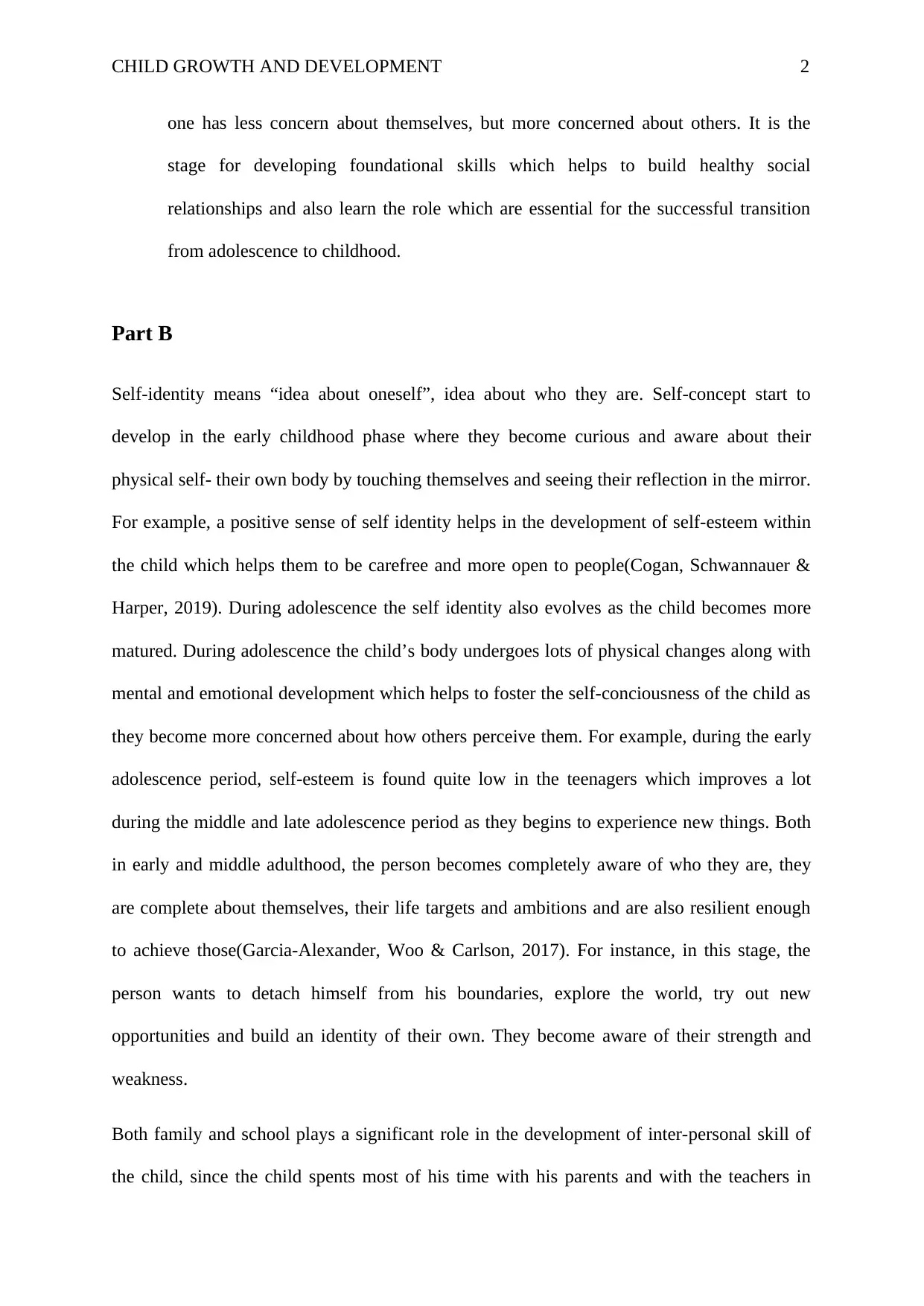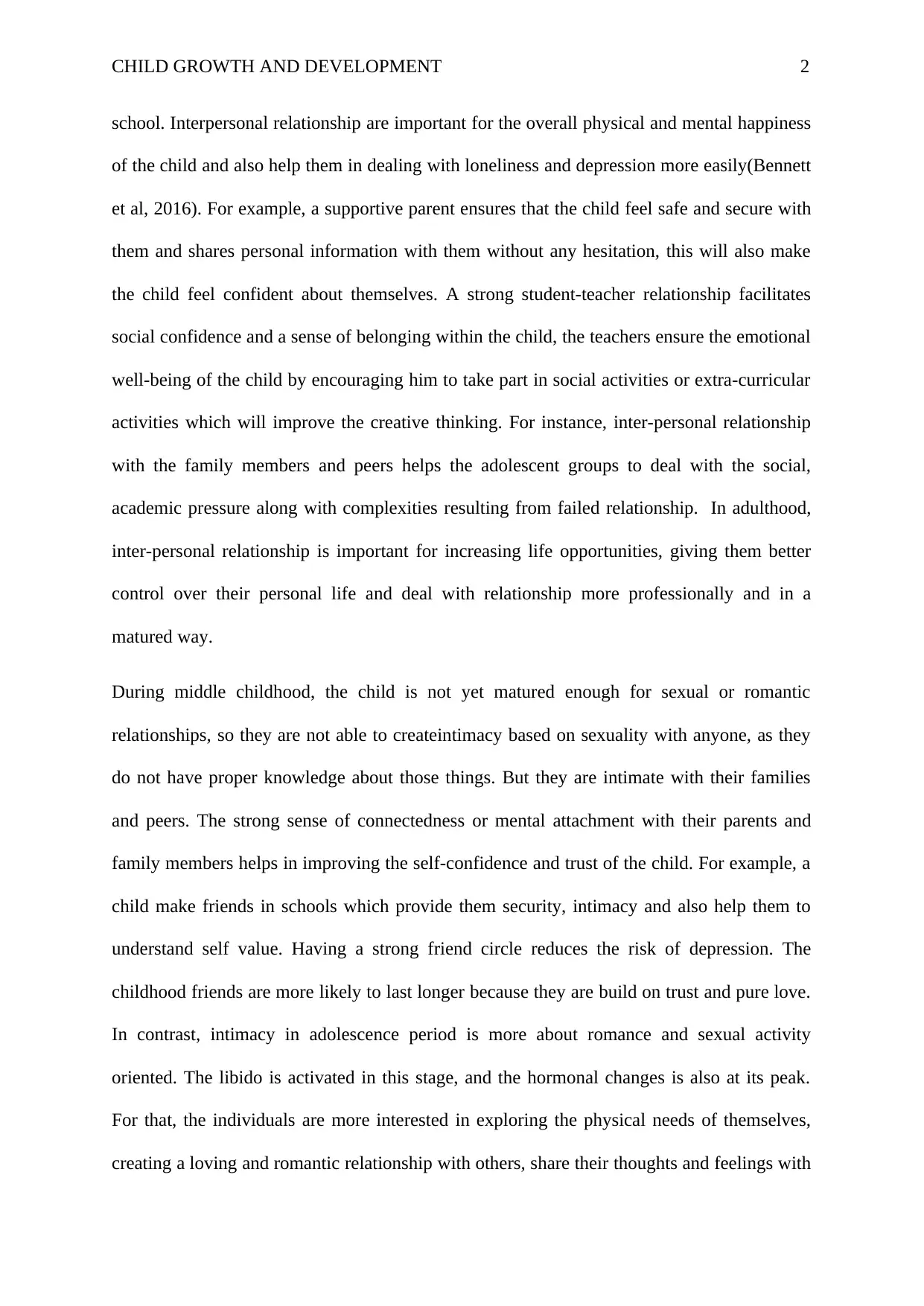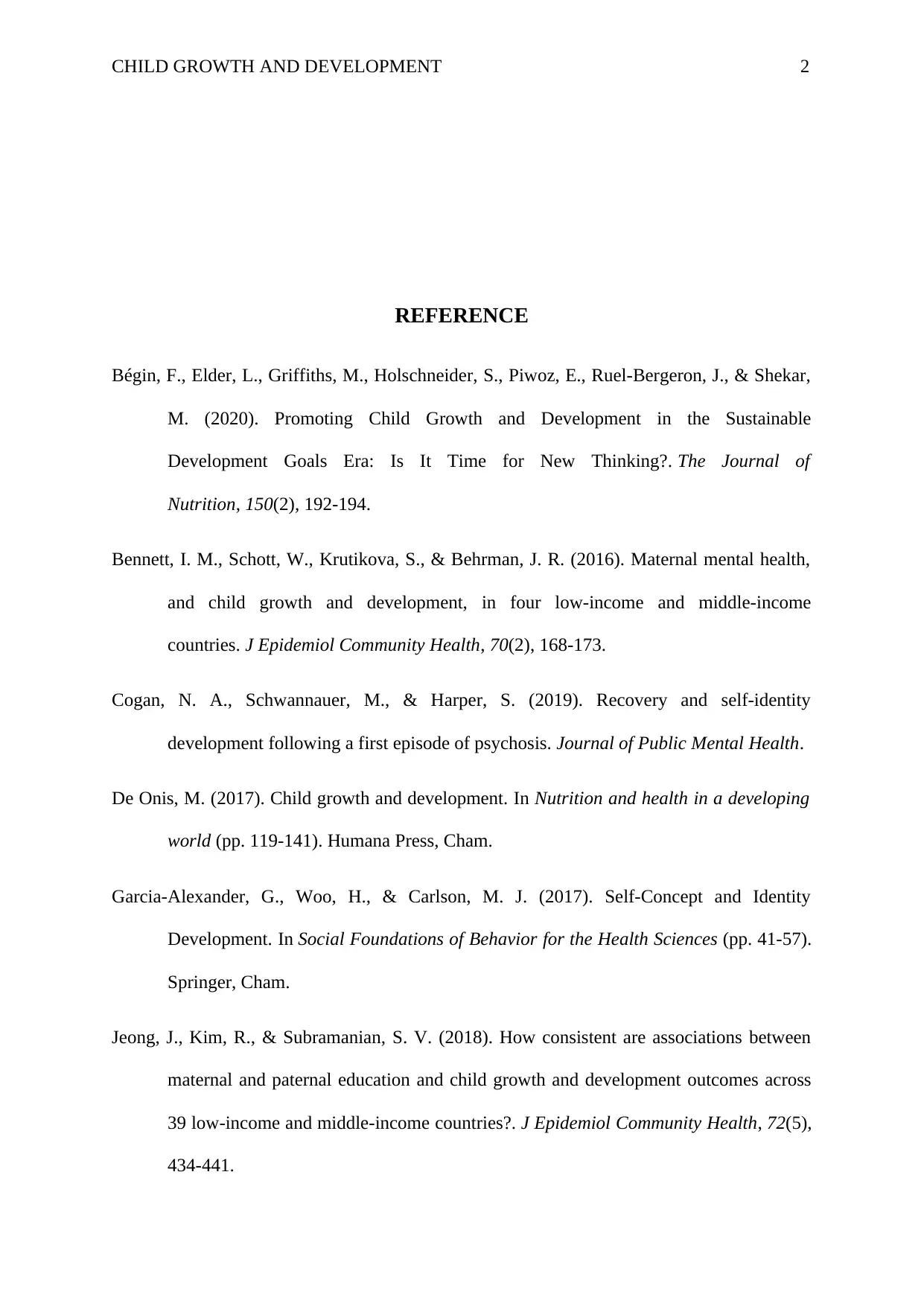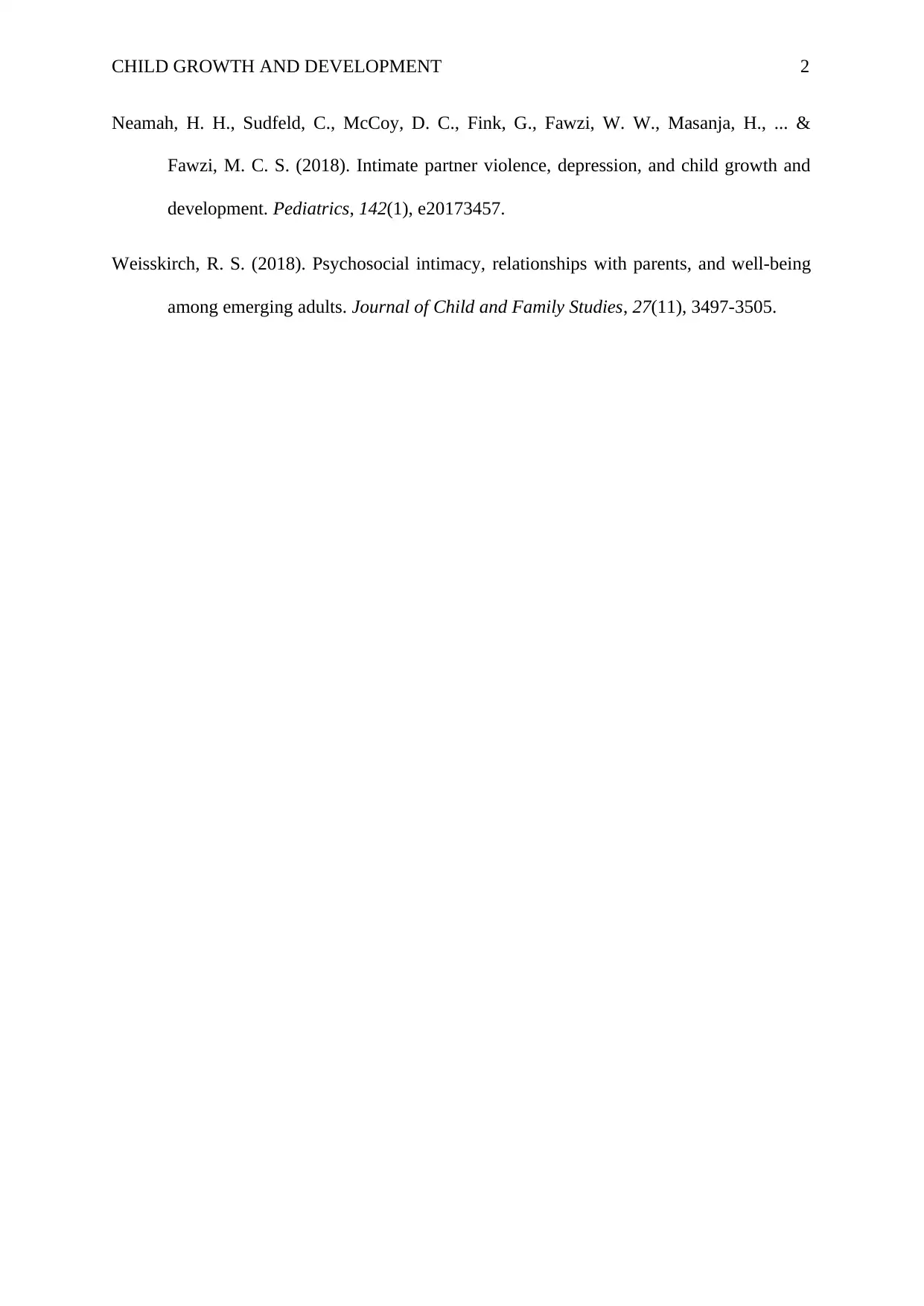Child Growth and Development: Self-Identity and Interpersonal Skills
VerifiedAdded on 2022/08/25
|8
|1948
|10
Report
AI Summary
This report provides an overview of child growth and development, focusing on the stages of middle childhood, adolescence, early adulthood, and middle adulthood. It examines the physical, cognitive, and social-emotional changes that occur during each stage. The report also explores the development of self-identity and the significance of interpersonal relationships within families, schools, and peer groups. It highlights how these relationships influence a child's self-esteem, social confidence, and ability to navigate various life challenges. Furthermore, the report discusses the importance of parental support and mentorship during the different developmental stages, emphasizing how these factors contribute to a child's overall well-being and ability to form healthy relationships. The report also provides a comparative analysis of intimacy and relationships across different developmental stages, highlighting the evolving nature of these connections and their impact on individual growth and professional development.

Running head: CHILD GROWTH AND DEVELOPMENT
Child Growth And Development
Name of the Student
Name of the University
Author Note
Child Growth And Development
Name of the Student
Name of the University
Author Note
Paraphrase This Document
Need a fresh take? Get an instant paraphrase of this document with our AI Paraphraser

CHILD GROWTH AND DEVELOPMENT 2
Part A
1. Middle Childhood
Middle childhood is that stage of a child development process where the child shows
slow and steady growth and progress towards puberty. A child of 6-8 years of age are
considered to be in the middle childhood stage. During middle childhood, the
muscular strength, motor skills, resistance power and stamina of the child increases
which helps them in performing complex movements and take part in physical
activities. There is also significant cognitive development of the child where they
improve their logical skills and memory(Bégin et al, 2020).
2. Adolescence
The adolescence period is the transitional stage where a child moves from the pubertal
stage to adulthood. A teenager within the age range of 10-13 years are considered to
be adolescent. At this stage the development rate is high. In males, growth of hairs
takes place under the arm and near the genitals, wheras females undergo breast
development.
3. Early adulthood
The early adulthood stage is that developnmental stage where the child completely
becomes a grown up individual, becomes independent and matured enough to take
decision on their own and explore life possibilities. The early adulthood stage lies in
the age range of 20-30years. They are more focussed and committed to their
responsibilities and serious about relationships(Bégin et al, 2020).
4. Middle Adulthood
Middle adulthood is the developmental stage which is the connecting link between
adulthood and old age. This period last from 40-65 years of age. Usually, at this time,
Part A
1. Middle Childhood
Middle childhood is that stage of a child development process where the child shows
slow and steady growth and progress towards puberty. A child of 6-8 years of age are
considered to be in the middle childhood stage. During middle childhood, the
muscular strength, motor skills, resistance power and stamina of the child increases
which helps them in performing complex movements and take part in physical
activities. There is also significant cognitive development of the child where they
improve their logical skills and memory(Bégin et al, 2020).
2. Adolescence
The adolescence period is the transitional stage where a child moves from the pubertal
stage to adulthood. A teenager within the age range of 10-13 years are considered to
be adolescent. At this stage the development rate is high. In males, growth of hairs
takes place under the arm and near the genitals, wheras females undergo breast
development.
3. Early adulthood
The early adulthood stage is that developnmental stage where the child completely
becomes a grown up individual, becomes independent and matured enough to take
decision on their own and explore life possibilities. The early adulthood stage lies in
the age range of 20-30years. They are more focussed and committed to their
responsibilities and serious about relationships(Bégin et al, 2020).
4. Middle Adulthood
Middle adulthood is the developmental stage which is the connecting link between
adulthood and old age. This period last from 40-65 years of age. Usually, at this time,

CHILD GROWTH AND DEVELOPMENT 2
one has less concern about themselves, but more concerned about others. It is the
stage for developing foundational skills which helps to build healthy social
relationships and also learn the role which are essential for the successful transition
from adolescence to childhood.
Part B
Self-identity means “idea about oneself”, idea about who they are. Self-concept start to
develop in the early childhood phase where they become curious and aware about their
physical self- their own body by touching themselves and seeing their reflection in the mirror.
For example, a positive sense of self identity helps in the development of self-esteem within
the child which helps them to be carefree and more open to people(Cogan, Schwannauer &
Harper, 2019). During adolescence the self identity also evolves as the child becomes more
matured. During adolescence the child’s body undergoes lots of physical changes along with
mental and emotional development which helps to foster the self-conciousness of the child as
they become more concerned about how others perceive them. For example, during the early
adolescence period, self-esteem is found quite low in the teenagers which improves a lot
during the middle and late adolescence period as they begins to experience new things. Both
in early and middle adulthood, the person becomes completely aware of who they are, they
are complete about themselves, their life targets and ambitions and are also resilient enough
to achieve those(Garcia-Alexander, Woo & Carlson, 2017). For instance, in this stage, the
person wants to detach himself from his boundaries, explore the world, try out new
opportunities and build an identity of their own. They become aware of their strength and
weakness.
Both family and school plays a significant role in the development of inter-personal skill of
the child, since the child spents most of his time with his parents and with the teachers in
one has less concern about themselves, but more concerned about others. It is the
stage for developing foundational skills which helps to build healthy social
relationships and also learn the role which are essential for the successful transition
from adolescence to childhood.
Part B
Self-identity means “idea about oneself”, idea about who they are. Self-concept start to
develop in the early childhood phase where they become curious and aware about their
physical self- their own body by touching themselves and seeing their reflection in the mirror.
For example, a positive sense of self identity helps in the development of self-esteem within
the child which helps them to be carefree and more open to people(Cogan, Schwannauer &
Harper, 2019). During adolescence the self identity also evolves as the child becomes more
matured. During adolescence the child’s body undergoes lots of physical changes along with
mental and emotional development which helps to foster the self-conciousness of the child as
they become more concerned about how others perceive them. For example, during the early
adolescence period, self-esteem is found quite low in the teenagers which improves a lot
during the middle and late adolescence period as they begins to experience new things. Both
in early and middle adulthood, the person becomes completely aware of who they are, they
are complete about themselves, their life targets and ambitions and are also resilient enough
to achieve those(Garcia-Alexander, Woo & Carlson, 2017). For instance, in this stage, the
person wants to detach himself from his boundaries, explore the world, try out new
opportunities and build an identity of their own. They become aware of their strength and
weakness.
Both family and school plays a significant role in the development of inter-personal skill of
the child, since the child spents most of his time with his parents and with the teachers in
⊘ This is a preview!⊘
Do you want full access?
Subscribe today to unlock all pages.

Trusted by 1+ million students worldwide

CHILD GROWTH AND DEVELOPMENT 2
school. Interpersonal relationship are important for the overall physical and mental happiness
of the child and also help them in dealing with loneliness and depression more easily(Bennett
et al, 2016). For example, a supportive parent ensures that the child feel safe and secure with
them and shares personal information with them without any hesitation, this will also make
the child feel confident about themselves. A strong student-teacher relationship facilitates
social confidence and a sense of belonging within the child, the teachers ensure the emotional
well-being of the child by encouraging him to take part in social activities or extra-curricular
activities which will improve the creative thinking. For instance, inter-personal relationship
with the family members and peers helps the adolescent groups to deal with the social,
academic pressure along with complexities resulting from failed relationship. In adulthood,
inter-personal relationship is important for increasing life opportunities, giving them better
control over their personal life and deal with relationship more professionally and in a
matured way.
During middle childhood, the child is not yet matured enough for sexual or romantic
relationships, so they are not able to createintimacy based on sexuality with anyone, as they
do not have proper knowledge about those things. But they are intimate with their families
and peers. The strong sense of connectedness or mental attachment with their parents and
family members helps in improving the self-confidence and trust of the child. For example, a
child make friends in schools which provide them security, intimacy and also help them to
understand self value. Having a strong friend circle reduces the risk of depression. The
childhood friends are more likely to last longer because they are build on trust and pure love.
In contrast, intimacy in adolescence period is more about romance and sexual activity
oriented. The libido is activated in this stage, and the hormonal changes is also at its peak.
For that, the individuals are more interested in exploring the physical needs of themselves,
creating a loving and romantic relationship with others, share their thoughts and feelings with
school. Interpersonal relationship are important for the overall physical and mental happiness
of the child and also help them in dealing with loneliness and depression more easily(Bennett
et al, 2016). For example, a supportive parent ensures that the child feel safe and secure with
them and shares personal information with them without any hesitation, this will also make
the child feel confident about themselves. A strong student-teacher relationship facilitates
social confidence and a sense of belonging within the child, the teachers ensure the emotional
well-being of the child by encouraging him to take part in social activities or extra-curricular
activities which will improve the creative thinking. For instance, inter-personal relationship
with the family members and peers helps the adolescent groups to deal with the social,
academic pressure along with complexities resulting from failed relationship. In adulthood,
inter-personal relationship is important for increasing life opportunities, giving them better
control over their personal life and deal with relationship more professionally and in a
matured way.
During middle childhood, the child is not yet matured enough for sexual or romantic
relationships, so they are not able to createintimacy based on sexuality with anyone, as they
do not have proper knowledge about those things. But they are intimate with their families
and peers. The strong sense of connectedness or mental attachment with their parents and
family members helps in improving the self-confidence and trust of the child. For example, a
child make friends in schools which provide them security, intimacy and also help them to
understand self value. Having a strong friend circle reduces the risk of depression. The
childhood friends are more likely to last longer because they are build on trust and pure love.
In contrast, intimacy in adolescence period is more about romance and sexual activity
oriented. The libido is activated in this stage, and the hormonal changes is also at its peak.
For that, the individuals are more interested in exploring the physical needs of themselves,
creating a loving and romantic relationship with others, share their thoughts and feelings with
Paraphrase This Document
Need a fresh take? Get an instant paraphrase of this document with our AI Paraphraser

CHILD GROWTH AND DEVELOPMENT 2
their partner whom they can trust, getting physically and mentally intimate with
them(Weisskirch, 2018). The relationships created at this stage are less likely to last long. In
early adulthood and middle adulthood, the person becomes more matured and looks forward
to create relationships, which will help them to achieve their goals and ambitions. It is more
of a professional intimacy, than an emotional. For example, a good relationship of an
individual with his teachers, professionals or fellow students will facilitate wider connection
with people thus increasing the possibility of job opportunities.
In early adulthood, the individual is in its peak form, body is full of energy and remains
spiritually boosted and enthusiastic. They are more dedicated and committed towards their
professional goals and ambitions, get out from their boundaries and explore the world around
them. Their cognitive abilities are also efficient with strong memory and usually based on
realistic and practical thinking. Whereas, in middle adulthood, the energy begins to drain
from one’s body, the enthusiasm and spiritualism within an individual is also reduced,
amking them more lethargic. The individual also loses his cognitive senses as they suffer
from memory loss, vision problem and hearing loss(De Onis, 2017).
Part C
From the above discussion, it is clear that for a perfect development of a child, the role of the
parents, family members and peers are very important. The early childhood is the most
intensive and initial stage of development of the child and needs maximum care. This is the
stage where the child learn the basic things about life which will guide them forever, so if
they are not taken taken take of properly, they may get take unhealthy life choices in the
future. For example, a child who is physically or mentally abused by their parents, often
becomes arrogant and chose the path of violence in future(Jeong, Kim & Subramanian,
2018). The adolescent period is the most unstable and turbulent stage of a child, at this stage
their partner whom they can trust, getting physically and mentally intimate with
them(Weisskirch, 2018). The relationships created at this stage are less likely to last long. In
early adulthood and middle adulthood, the person becomes more matured and looks forward
to create relationships, which will help them to achieve their goals and ambitions. It is more
of a professional intimacy, than an emotional. For example, a good relationship of an
individual with his teachers, professionals or fellow students will facilitate wider connection
with people thus increasing the possibility of job opportunities.
In early adulthood, the individual is in its peak form, body is full of energy and remains
spiritually boosted and enthusiastic. They are more dedicated and committed towards their
professional goals and ambitions, get out from their boundaries and explore the world around
them. Their cognitive abilities are also efficient with strong memory and usually based on
realistic and practical thinking. Whereas, in middle adulthood, the energy begins to drain
from one’s body, the enthusiasm and spiritualism within an individual is also reduced,
amking them more lethargic. The individual also loses his cognitive senses as they suffer
from memory loss, vision problem and hearing loss(De Onis, 2017).
Part C
From the above discussion, it is clear that for a perfect development of a child, the role of the
parents, family members and peers are very important. The early childhood is the most
intensive and initial stage of development of the child and needs maximum care. This is the
stage where the child learn the basic things about life which will guide them forever, so if
they are not taken taken take of properly, they may get take unhealthy life choices in the
future. For example, a child who is physically or mentally abused by their parents, often
becomes arrogant and chose the path of violence in future(Jeong, Kim & Subramanian,
2018). The adolescent period is the most unstable and turbulent stage of a child, at this stage

CHILD GROWTH AND DEVELOPMENT 2
numerous thoughts and emotions comes together in the chil’s mind making it difficult for
them to decide what is wrong and what is right. The child is more concerned about what
others thinks about them rather than what he thinks about himself, self identity and self
esteem is low at this stage and often there is academic loss as the child remains more busy in
making relationship and intimacy with others. So a mentor or guide is required to guide the
teens during this crucial phase of their life. For example, having a supportive parent, sibling
or a close friend can help the teens to deal with heartbreak more easily and reduce the chance
of depression(Neamah et al, 2018). The adulthood is the most balanced and matured stage in
a man’s life, here the individual knows exactly what he is doing and is accountable for that.
So they do not need any extra guidance as they are matured enough to deal with their stress
efficiently and professionally.
numerous thoughts and emotions comes together in the chil’s mind making it difficult for
them to decide what is wrong and what is right. The child is more concerned about what
others thinks about them rather than what he thinks about himself, self identity and self
esteem is low at this stage and often there is academic loss as the child remains more busy in
making relationship and intimacy with others. So a mentor or guide is required to guide the
teens during this crucial phase of their life. For example, having a supportive parent, sibling
or a close friend can help the teens to deal with heartbreak more easily and reduce the chance
of depression(Neamah et al, 2018). The adulthood is the most balanced and matured stage in
a man’s life, here the individual knows exactly what he is doing and is accountable for that.
So they do not need any extra guidance as they are matured enough to deal with their stress
efficiently and professionally.
⊘ This is a preview!⊘
Do you want full access?
Subscribe today to unlock all pages.

Trusted by 1+ million students worldwide

CHILD GROWTH AND DEVELOPMENT 2
REFERENCE
Bégin, F., Elder, L., Griffiths, M., Holschneider, S., Piwoz, E., Ruel-Bergeron, J., & Shekar,
M. (2020). Promoting Child Growth and Development in the Sustainable
Development Goals Era: Is It Time for New Thinking?. The Journal of
Nutrition, 150(2), 192-194.
Bennett, I. M., Schott, W., Krutikova, S., & Behrman, J. R. (2016). Maternal mental health,
and child growth and development, in four low-income and middle-income
countries. J Epidemiol Community Health, 70(2), 168-173.
Cogan, N. A., Schwannauer, M., & Harper, S. (2019). Recovery and self-identity
development following a first episode of psychosis. Journal of Public Mental Health.
De Onis, M. (2017). Child growth and development. In Nutrition and health in a developing
world (pp. 119-141). Humana Press, Cham.
Garcia-Alexander, G., Woo, H., & Carlson, M. J. (2017). Self-Concept and Identity
Development. In Social Foundations of Behavior for the Health Sciences (pp. 41-57).
Springer, Cham.
Jeong, J., Kim, R., & Subramanian, S. V. (2018). How consistent are associations between
maternal and paternal education and child growth and development outcomes across
39 low-income and middle-income countries?. J Epidemiol Community Health, 72(5),
434-441.
REFERENCE
Bégin, F., Elder, L., Griffiths, M., Holschneider, S., Piwoz, E., Ruel-Bergeron, J., & Shekar,
M. (2020). Promoting Child Growth and Development in the Sustainable
Development Goals Era: Is It Time for New Thinking?. The Journal of
Nutrition, 150(2), 192-194.
Bennett, I. M., Schott, W., Krutikova, S., & Behrman, J. R. (2016). Maternal mental health,
and child growth and development, in four low-income and middle-income
countries. J Epidemiol Community Health, 70(2), 168-173.
Cogan, N. A., Schwannauer, M., & Harper, S. (2019). Recovery and self-identity
development following a first episode of psychosis. Journal of Public Mental Health.
De Onis, M. (2017). Child growth and development. In Nutrition and health in a developing
world (pp. 119-141). Humana Press, Cham.
Garcia-Alexander, G., Woo, H., & Carlson, M. J. (2017). Self-Concept and Identity
Development. In Social Foundations of Behavior for the Health Sciences (pp. 41-57).
Springer, Cham.
Jeong, J., Kim, R., & Subramanian, S. V. (2018). How consistent are associations between
maternal and paternal education and child growth and development outcomes across
39 low-income and middle-income countries?. J Epidemiol Community Health, 72(5),
434-441.
Paraphrase This Document
Need a fresh take? Get an instant paraphrase of this document with our AI Paraphraser

CHILD GROWTH AND DEVELOPMENT 2
Neamah, H. H., Sudfeld, C., McCoy, D. C., Fink, G., Fawzi, W. W., Masanja, H., ... &
Fawzi, M. C. S. (2018). Intimate partner violence, depression, and child growth and
development. Pediatrics, 142(1), e20173457.
Weisskirch, R. S. (2018). Psychosocial intimacy, relationships with parents, and well-being
among emerging adults. Journal of Child and Family Studies, 27(11), 3497-3505.
Neamah, H. H., Sudfeld, C., McCoy, D. C., Fink, G., Fawzi, W. W., Masanja, H., ... &
Fawzi, M. C. S. (2018). Intimate partner violence, depression, and child growth and
development. Pediatrics, 142(1), e20173457.
Weisskirch, R. S. (2018). Psychosocial intimacy, relationships with parents, and well-being
among emerging adults. Journal of Child and Family Studies, 27(11), 3497-3505.
1 out of 8
Related Documents
Your All-in-One AI-Powered Toolkit for Academic Success.
+13062052269
info@desklib.com
Available 24*7 on WhatsApp / Email
![[object Object]](/_next/static/media/star-bottom.7253800d.svg)
Unlock your academic potential
Copyright © 2020–2025 A2Z Services. All Rights Reserved. Developed and managed by ZUCOL.





